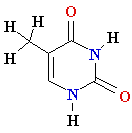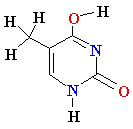Problem
Set # 1: DNA structure and replication
PDB reference
correction and design Dr.chem., Ph.D. Aris Kaksis, Associate Professor
Note: this assignment will not be graded.
DNA Structure
1. Draw
molecular structures for the following compounds.
a) 2’-deoxy
Thymidine 5’-monophosphate
b) Guanosine
c) Uridine
5’-diphosphate
2. Name
the following 4 nucleosides and nucleotides




3. Draw a complementary strand for the
following two 2 DNA single strand
molecules:
5’ A G C T A
C T G
C A
T T C
G A
A G
U
5’ G C T
T A G G C T
A C
T G A A C T G
4. Use arrows to show the bonds cleaved
by each of the following enzymes:
a) 3’-exonuclease
b) 5’-exonuclease
A
G
A
C
T
A
|
|
|
|
|
|
5' |\O-PO |\O-P-O |\O-P-O |\O-P-O |\O-P-O |\-O-H
3'
HO-\| \|
\|
\|
\|
\|
5. How many fragments of DNA
are
produced by the action of the restriction
enzyme Taq1 on the following strand
of DNA. The recognition sequence of TaqI
is T C G A
5’ A A
C T C G A T
T C T C
G A
A C
C G
A A
C |T C
G A |T
T C |T C G A
|A
C C G
3’ T T
G A
G C
T A A G A G C T T G G C T T G |A G C
T |A A G |A G C T
| T G G C
6.
Which of the following sequences is
likely to be a Restriction Endonuclease
site E.colli and why ?
G T A
T A G
G T T A
A C G T
T A A C
A G
G C
C T
T
A A
G C
C
7.
Why is DNA a better means of storing
genetic information than RNA ?
8.
Predict which of the following DNA
duplexes melts at a higher
temperature T. Explain why?!
How would the melting temperature T
change if [Mg2+]
was increased
from 0.1 mM to 0.1 M ?
a) CGGA T
G C T AA T T T CC
T AAA
T C
GCC T AC G A T T A AAGG A TTT A
G
b) CGGC T A
G CGCC GCGC T T A
CG
GCCGA T C
GCGG CGCG A A T
GC
9. A small portion of thymine
nucleo-base can exist as enol
tautomer.
How are the H-bonding
characteristics of T
affected in its enol form? What nucleo-base
is likely to base-pair with the enol
form of T?
What mutation would result?
Thymine enol
tautomerisation
equilibrium 


2. DNA Synthesis,
Damage, and Repair
1. Explain the function of magnesium ions Mg2+ in
the active site of DNA Pol I
.
2. Explain the "end-replication"
problem for linear chromosomes. Name
the specialized enzyme utilized to synthesize the ends
of chromosomes and
give a brief description of how it works.
3. AZT (3’-azido-2’,3’-di-deoxy- thymidine)
is an important drug for the treatment of AIDS.
Draw the structure of
AZT and explain the mechanism of its action.
4. Name two 2 human
diseases caused by defects in different DNA
repair pathways.
List (briefly!) the steps in each pathway.
5. Draw a structural diagram of the compound resulting
from deamination of 5-methyl cytosine.
What is the name of this compound? What nucleobase is
likely to basepair with it? What mutation
would result?
6. Which of the following repair pathways are capable
of repairing
the damage resulting from deamination
of 5-methyl cytosine:
a. Direct reversal by photolyase
b. Direct reversal by O6-methyl-guanine-DNA
methyltransferase
c. Mismatch repair
d. Base excision repair
e. Nucleotide excision repair
f. Recombination
7. Draw the replication fork
and describe the role of each protein involved in DNA
replication in E Coli.
8. How do mismatch repair
proteins recognize the newly
synthesized DNA strand ?
9. Ganciclovir (see below) is a guanine nucleoside analog used in
the therapy of cytomegalo-virus and herpes
virus infection.

a) Predict ganciclovir mechanism of
action (use
structures to illustrate your answer)
b) What enzymes are likely to perform ganciclovir
conversion to the active
form?
Draw the structure of the activated ganciclovir.
10. O6-benzylguanine (O6-Bz-G) is
currently in clinical trials for use in antitumor
therapy.
It is used in
combination with alkylating agents (e.g. nitroso-ureas)
and acts by enhancing
the effects of
these
drugs.
a)
Draw the structure of
O6-Bz-G
b)
Using your knowledge of DNA
repair, predict the mechanism of action of O6-Bz-G.
c)
Would you expect O6-Bz-G to have side effects
in normal cells?






